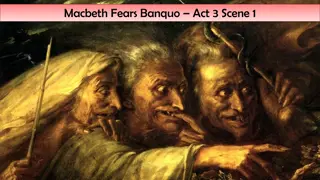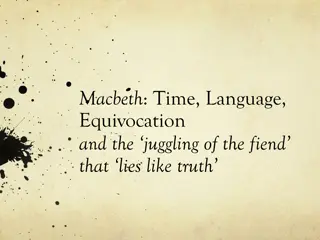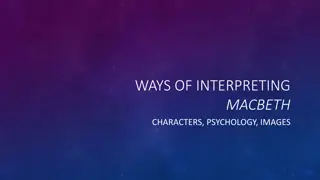Literary Devices in Macbeth: Text Response Assessment Preparation
Exploring literary devices in Macbeth reveals the use of aside for character insights, imagery to evoke sensations, verbal irony for hidden meanings, dramatic irony for contrasts, and metaphors for rich associations. These elements deepen the understanding of characters and themes in Shakespeare's play, enhancing analysis and interpretation for academic assessments.
Download Presentation

Please find below an Image/Link to download the presentation.
The content on the website is provided AS IS for your information and personal use only. It may not be sold, licensed, or shared on other websites without obtaining consent from the author.If you encounter any issues during the download, it is possible that the publisher has removed the file from their server.
You are allowed to download the files provided on this website for personal or commercial use, subject to the condition that they are used lawfully. All files are the property of their respective owners.
The content on the website is provided AS IS for your information and personal use only. It may not be sold, licensed, or shared on other websites without obtaining consent from the author.
E N D
Presentation Transcript
Literary Devices in Macbeth Preparation for the Text Response Assessment Task
Aside Words spoken by an actor sometimes a loud whisper which are heard by the audience, but are not supposed to be heard by the other characters on the stage.
Imagery An image is a word or a group of words which suggests a sensation. Thus an object, a sound, a movement, a smell can all be images. Imagery is figurative and involves associations. For example, Lady Macbeth says: The raven himself is hoarse The croaks the fatal entrance of Duncan The image of the raven is particularly appropriate be- cause ravens were often seen cleaning the hones of those who had been executed. Duncan is going to his death and it is as if the raven anticipate-s the meal he might make of Duncan s corpse. The word hoarse suggests that the raven had been making a noise for some time as it looks forward to Duncan s fatal entrance into the castle, and as a result its voice is now croaking . Both hoarse and croaks have unpleasant associations that would be fitting to a creature that feeds off dead bodies. In addition, the raven is traditionally associated with evil omens. A raven seen croaking near a building was believed to be speaking of an approaching danger to the inhabitants of that building.
Verbal Irony Irony - verbal occurs when a character is aware or unaware that there is a hidden meaning behind what is said. Irony occurs when a character is aware or unaware that there is a hidden meaning behind what is said. usually a contrast between what is said and the underlying meaning. For example, when Duncan s visit is announced Lady Macbeth says: He that s coming Must be provided for She can be understood on two levels: she is referring to her duties as a hostess, but she is also saving that arrangements must be made to murder Duncan. The contrast between the two meanings is clear.
Dramatic Irony Irony of situation - Dramatic irony As in verbal irony, contrast is involved. In ironical situations there is a contrast between what someone thinks or says and the true state of affairs. For example, Macbeth and Lady Macbeth think they will achieve great happiness by killing Duncan. But this contrasts with (is opposite to) the true state of affairs which involves the loss of all their happiness. It is also ironical that Lady Macbeth sees herself as strong and Macbeth as weak . This view contrasts with the true state of affairs Lady Macbeth collapses under the strain of her evil deeds, but Macbeth finds the strength to carry on. a contrast between what is said and the underlying meaning. For example, when Duncan s visit is announced Lady Macbeth says:
Metaphor A metaphor is sometimes defined as a condensed comparison a condensed simile without the link words Peter is a bean-pole. He is an angry dog. A metaphor is probably the commonest feature of poetry. It has the power to condense two or more worlds of experience, and so creates associations. It brings together two totally different objects arid gives us a new insight into them. For example, when Macbeth says to Lady Macbeth, O full of scorpions is my mind, dear wife the metaphor is particularly rich in associations.
Simile The simile is a form of comparison of two things from different categories. The word linking the two compared things is very often as , like or than . For example: Peter is as tall as a bean-pole. He looked like an angry dog. "And pity, like a naked new-born babe." Act I, Scene 7
Soliloquy When a character speaks his deepest thoughts aloud to himself when he is alone, he speaks a soliloquy or he soliloquizes.This dramatic technique enables the audience to know what is going on in the privacy of a character s mind. For example: Macbeth s speech: Tomorrow and tomorrow and tomorrow .
Symbol A symbol is an object, creature, person, action or situation which is part of a larger unit. This larger unit is often abstract and inexpressible, and thus requires something more concrete to give at expression. For example: A flag is a symbol of a nation. A rose is a symbol of love. In Macbeth, Macbeth s castle becomes a symbol of hell when the murder of Duncan takes place. The witches are symbols of evil. The growing tree and Birnam Wood are symbols of good, of healthy growth. A writer often employs symbolism,and uses symbolic images.
Personification Personification is a statement which gives human characteristics to something which is (1) not human or (2) to an abstract idea. For example: 1. The moon smiled shyly at the lovers. 2. Time marches on. In Romeo and Juliet when Romeo first sees Juliet on the balcony, he says: Arise fair sun and kill the envious moon, Who is already sack and pale with grief. In Hamlet, Horatio describes daybreak in the lines: But look, the morn in russet mantle clad, Walks o er the dew of von high eastern hill. Personification is a form of metaphor.
Plot & Theme The plot is what happens in the story it is the order of events as arranged by the dramatist or the novelist. For example: Macbeth murders Duncan and takes has place on the throne of Scotland. He then begins a reign of terror which leads to a rebellion and ultimately his own death. The themes are the main ideas of the play. Theme is sometimes defined as the living idea which emerges from the plot. In a very complex play such as Macbeth there can be many themes, some obviously more important than others. See the Themes section for a discussion of theme .
Equivocation Nothing is, but what is not. Example: Parent: What time did you get in last night? You (an equivocating teenager): Well, we left the Civic Center at eleven, and it 's only a half hour drive, so there was plenty of time to be in by midnight. Were you home by midnight? You neglected to mention that you stopped for pizza and took the long way home. You didn t actually lie, but you deliberately tried to mislead your parent into believing something not true that you met your curfew. This above is an example of equivocation: the art of misleading, usually through language. An equivocator is a person who tries to mislead through language. a statement or event that is open to two or more interpretations and is actually intended to mislead. The two major elements of equivocation are: 1. A lie is not actually told 2. The truth is not told either, but a false idea is deliberately fostered. Macbeth equivocates; so do the witches; so does Lady Macbeth. Equivocation is everywhere; the atmosphere is thick with it. The action is motivated by it.
Fair is foul, foul is fair The day is indeed fair for Macbeth and Banquo, leaders of the king s forces, for they have defeated the rebels on the battlefield. But the day is also foul, for thunder is raging and lightening streaks across the sky; so fair and foul, opposite in meaning, seem to become equal. The witches here set the stage: little is as it seems to be. Banquo to Macbeth, after the first meeting with the witches: "oftentimes, to win us to our harm, / The instruments of darkness tell us truths, / Win us with honest trifles, to betray's / In deepest consequence" (1.3.123-126) What does this mean and what does it have to do with equivocation?























